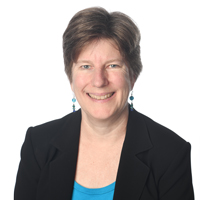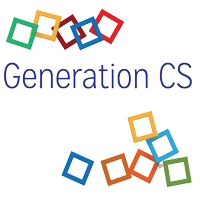Seven Tips for Advertising Your Graduate Program to Undergraduate Programs
By Janet Davis, Whitman College
Four years ago, I left a tenured faculty position at Grinnell, a selective liberal arts college, to found a brand new computer science program at Whitman, another selective liberal arts college. Since establishing this program, I’ve started to receive mailings not only from my own Ph.D. program, but from a range of graduate programs in computer science and related fields.
If you’re reading this, you probably care about attracting graduate student applicants from institutions like mine. If you don’t, you should: Baccalaureate colleges are second only to “very high research activity universities” in their institutional-yield ratios for graduates who go on to receive a doctorate in science or engineering.[1]
Similarly, I want to share information about graduate programs with my students, for several reasons. First, I want our majors to be successful and happy – and that means helping them to consider the range of opportunities open to them, including graduate study, rather than assuming they will work as programmers their whole career. Second, I want to get prospective students excited about the possibilities of computer science. And finally, I want to help women and students from other underrepresented groups feel like they belong in computer science.
In my first few years as chair, I’ve seen enough to reflect on what leads me to share information from graduate programs with my students. Here are my top seven recommendations.
1. Make your mailings “post-able.”
I’ve received many alumni magazines and newsletters from programs I have no relationship with. I confess, they go straight into the recycling. I don’t have time to read them, and neither do my faculty colleagues. If I’m looking for something to browse, I’m far more likely to pick up the latest CACM, which I have a hard enough time keeping up with.
When I was at Grinnell, my department hired a student to organize files of materials from graduate programs. I considered replicating this at Whitman, but quickly concluded it wasn’t worth the trouble. Today’s students will Google the programs and rankings they are interested in before they even consider cracking open a file cabinet.
What we do have is a tackboard in the hall outside our main lab classroom. Here’s a recent photo:

What’s on it? Information about our curriculum. An advertisement for a study abroad program. And several postcards and flyers from graduate programs.
I think this tackboard is really important, since computer science students peruse it while waiting for the class before theirs to empty out of the classroom. By the numbers, these are mainly students in our 100- and 200-level classes, many of whom have not yet declared a major. Students going to their art history, English, foreign language, mathematics, and religion classes pass by as well. When choosing what to post, I consider what will catch students’ eyes and what might plant a seed of curiosity about what is possible with an advanced degree in computer science.
So, instead of magazines, send small posters, flyers, or postcards. They will get seen by more undergraduates – and they will be more cost-effective to produce and mail, too.
2. Prominently display faculty research areas – or better yet, research problems.
Consider these two 8.5” x 5.5” postcards, one from the University of Albany and one from the University of Oklahoma:
 |
 |
Which do you see on our departmental tackboard above? Why?
While I’m impressed by Professor Zheleva’s NSF CAREER Award, I had to turn the postcard over to learn it was awarded for her work on “automating the measurement and management of the radio spectrum for future spectrum-sharing applications.” By contrast, the postcard from the University of Oklahoma tells me right away that Professor McGovern won awards for her work on “severe weather applications.” Some students might be curious enough to turn the postcard over and learn about her work to improve hail forecasts with NOAA’s Storm Prediction Center, saving lives and property. Perhaps some of our students from rural areas might even envision themselves following in her footsteps.
The front of a postcard or flyer must include research problems or areas. First, I advise students seeking a Ph.D. that they are not just looking for a good graduate program, they are looking for a program where they will be well-supported in pursuing their research interests. How will students decide what programs to learn more about if there is no indication of what they might study in those programs? Second, I’m mindful that women and underrepresented minorities are often motivated to study computer science by a desire to address problems that matter to them. The more such problems I can show to undecided students, the more likely it is that something might click. When a postcard or flyer headlines a concrete, relatable research problem, onto the tackboard it goes. If students won’t even see a research area, it’s hard to see how it’s worth the space.
3. Include photos, especially of faculty and students belonging to underrepresented groups.
What these two postcards share in common, which I really appreciate, are large photos of women faculty. If you look back at the photo of our tackboard, you’ll see a lot of faces. Why? Photos are colorful, and faces in particular tend to attract our attention. I prefer to post materials with photos of people because I think they will attract students’ attention to the tackboard as a whole. Moreover, you should want to attract students’ attention to your own materials, and this is too easy a strategy to pass up.
But more than just attracting attention, I want students from underrepresented groups to see potential role models and mentors in computer science research. If your materials show this, I am all the more likely to post them for my students to see.
4. Share what makes your program special.
What makes your program stand out from the others? What experiences and opportunities do you offer your graduate students that they might not get somewhere else? The UW Human-Centered Design & Engineering program touts the high proportion of women among its students and faculty. The University of Colorado, Boulder, advertises a new post-baccalaureate program in Applied Computer Science, which might appeal to our students who discover computer science too late in their undergraduate careers to pursue the major. The University of New Mexico Computer Science program shows students posing with a green alien doll, and asks, “Are you Querque enough?” What other program could do this? While it might be a turn-off to some prospective graduate students, it will strongly appeal to others.
While you’re doing this, make sure the name of your university is as visible as the name of your department or program. Look back at the photos above to see why.
5. Contribute to the CRA Member One-Pager Book.
The past two autumns, CRA Executive Director Andrew Bernat has requested our contributions to the CRA Member One-Pager book, released by email in October.
Does anybody look at this? I did! These one-pagers are just about perfect to post on our department tackboard. I printed the pages for our faculty’s Ph.D. institutions, as well as a few others I thought might appeal to our students. I would gladly share the whole document with students seeking a quick overview of many programs – it’s much easier to browse than a file cabinet.
So please, plan to contribute this fall. Applying the advice above: Remember that your audience may include not only colleagues and faculty candidates, but also undergraduates applying to graduate programs, or those who might be inspired to do so. With that in mind, highlight concrete research problems or accomplishments, as well as broad research areas. Show us eye-catching photos that illustrate the diversity of your faculty and students. And last but not least, spend some time reflecting on how to communicate what makes your program unique
6. Offer a personal touch.
Last year I received a letter in the mail from Michelle Strout, Acting Chair of Computer Science at the University of Arizona, in which she outlined her program’s interest in receiving applications from students at liberal arts colleges. She pointed out that her program is excellent but small, providing the community and close relationships that liberal arts college students sought out in their undergraduate institutions and might seek in a graduate program as well. You can bet I made a point of talking with Professor Strout when I encountered her at the CRA-W Mid Career Mentoring Workshop last fall in Phoenix. And soon after, I encouraged our strongest senior to consider her program. He ended up deciding to postpone graduate applications for a year or two, but I wouldn’t be surprised if the University of Arizona remains on his list.
7. Maintain relationships with alumni working at primarily undergraduate institutions.
As mentioned earlier, I made a point of posting materials advertising our faculty’s Ph.D. institutions: the Universities of Illinois, Minnesota, New Mexico, and Washington. While UW CSE has grown and changed since I was a student, I remain justifiably proud of my alma mater. I want to ensure that all our home institutions are represented so that curious students can ask us questions about what our programs were like.
My good feelings about my graduate program persist in part because faculty have respected my career choices and made me continue to feel part of the family – beyond my relationship with my graduate advisor and beyond asking me for money. For instance, I had a good chair-to-chair dinner conversation with Hank Levy when we both mistook the date for my advisor’s retirement party. Dan Grossman reached out to me seeking advice for students interested in careers similar to mine, and invited me to stage a departmental colloquium on teaching-oriented career paths. Richard Ladner always has a friendly word for me when we see each other at conferences (both CHI and SIGCSE), and he has also introduced me to his students interested in faculty careers at liberal arts colleges. And I shouldn’t forget it was past chair Ed Lazowska who invited me five and a half years ago to share my expertise with Whitman’s Computer Science Advisory Board. Considering these examples, department chairs and past chairs, graduate program directors, colloquium organizers, and faculty in nearby research areas can all play a role.
In this essay I focused on print materials, but similar advice may apply to digital materials such as program websites, and especially emails advertising graduate programs. I rarely receive such emails from U.S. institutions, but when I do I am thrilled to forward them to our well-read CS Announcements email list.
I hesitate a little to call out blunders and share little-known advertising strategies. I don’t want to ruffle any feathers. But I think it benefits everyone when graduate programs present themselves as effectively as they can.
I look forward to receiving your new promotional materials in the academic year to come. Maybe I will need a bigger tackboard to post them all!
Do you have more tips to share? Please send your thoughts to crnonline@cra.org/cra.
Acknowledgements
Thanks to John Stratton and Gillian Frew for their helpful feedback.
About the author
Janet Davis earned her B.S. in computer science at Harvey Mudd College and her M.S. and Ph.D. at the University of Washington. Before joining Whitman College in 2015 to found its new computer science program, she spent nine years at Grinnell College, rising to the rank of Associate Professor and serving as Director of the Wilson Program in Enterprise and Leadership. She is a member of the Liberal Arts Computer Science Consortium and a co-convener of the SIGCSE Committee on Computing Education in Liberal Arts Colleges. Her research in human-computer interaction concerns values and participation in the design of persuasive technology, currently focusing on applications intended to influence language use.
[1] Mark K. Fiegener and Steven L. Proudfoot. Baccalaureate Origins of U.S.-trained S&E Doctorate Recipients. NSF 13-323, April 2013. https://www.nsf.gov/statistics/infbrief/nsf13323/



